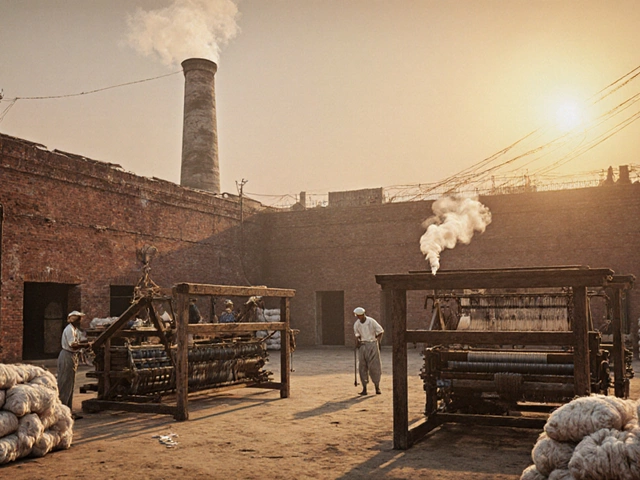Most people think opening a small scale industry is a big maze of paperwork and heavy investment. Honestly, you can sidestep a lot of headaches by starting with a single decision: what problem are you solving? Products that fix daily annoyances almost always sell, especially if you keep things simple—think handmade soap, specialty snacks, or affordable furniture. Instead of chasing every hot trend, look at what your local market actually lacks. Check out street markets, ask friends, look for things people import from far away but would buy locally if they could.
Once you spot a gap, research how much it’ll cost to make your idea a real product. Don’t guess—ask small shop owners, suppliers, even folks who tried and failed before. You’ll save cash and avoid newbie mistakes. Quick tip: used machines and shared workspaces can slash start-up costs. If you can start from your garage or tiny rented shop, do it. There’s no trophy for getting fancy too soon.
- Spotting the Right Opportunity
- Sorting Out Licenses and Legal Stuff
- Planning Finances Without Losing Your Mind
- Setting Up Your Space and Crew
- First Production Run and Getting Customers
Spotting the Right Opportunity
If you want to start a small scale industry, you need to pick the right product or service from the beginning. Jumping into any random idea because it's trending on social media? That’s risky. Instead, look around your local area. What’s missing? Maybe it’s affordable packaging materials for small shops, or maybe nobody near you makes quality bread that isn’t from a big factory.
It’s not about reinventing the wheel. Some of the most successful manufacturing start-ups focus on basics like eco-friendly cleaning products, simple food processing (like local jam), or making low-cost concrete blocks for construction. Need proof? According to a small business report from India’s Ministry of MSME, nearly 40% of successful new businesses in the past three years started by improving or localizing stuff people already needed and bought regularly.
If you’re stuck, here’s a down-to-earth trick: make a list of things you and your neighbors buy all the time. Next, cross out everything already covered by big brands or chain stores. What’s left is your hunting ground. For extra points, chat with small shop owners or street vendors, because they know exactly what customers complain about not finding or what sells out too fast.
- Check demand in your town or district before picking a product.
- Ask shopkeepers what sells fastest or what people ask for, but can’t find easily.
- Watch for rising trends—solar-powered gadgets, low-sugar snacks, natural cosmetics are picking up steam in many places.
- Avoid products that need huge investment in fancy machines if you’re just starting out.
- Spend time reading local online forums and community groups. People talk about stuff they wish was available.
Another good move is to visit local industrial parks or small business expos—you’ll see what’s popular, but also spot gaps. Keep your phone notes handy and make lists.
| Product Type | Initial Investment (USD) | Ease of Start-Up |
|---|---|---|
| Handmade Soap | $500-$1,000 | Easy |
| Packaged Snacks | $800-$2,500 | Medium |
| Custom Furniture | $2,000-$5,000 | Medium |
Here’s the thing—opportunities don’t always scream for attention. Sometimes, the best business setup ideas seem boring or ordinary. But if enough people want it and no one else is making it nearby, that’s your opening. Don’t overthink or wait for the ‘perfect’ idea—you can tweak things as you go.
Sorting Out Licenses and Legal Stuff
Getting the paperwork right is probably the least exciting part of launching a small scale industry, but it’s also the part that saves you the most trouble later. Every country—and sometimes even each city—has its own must-haves. So, before you spend any real money, check exactly what’s needed where you live. Most folks miss a simple document and end up dealing with fines or shutdowns. It's not worth the risk.
If you’re in India, for example, you need to register your business under the Micro, Small & Medium Enterprises (MSME) Act—now called Udyam Registration. In the US, local zoning permits and a federal Employer Identification Number (EIN) are the first steps. Every spot wants you to have:
- A business license or registration
- Tax documents (GST, VAT, or sales tax ID depending on your region)
- A pollution or environmental clearance if you’re making stuff with chemicals or waste
- Factory or shop & establishment license
- Fire and safety certifications (even if you’re running tiny equipment)
Here’s a simple breakdown of what usually happens:
- Pick your type of business structure (sole proprietorship, partnership, LLC, or limited company).
- Get your business name approved—it doesn’t have to be fancy, just available and clear.
- Apply for licenses and local permits (either online or at a local office—these days, online is way faster).
- If you have workers, register for employee-related policies (like health or accidental coverage—sometimes required even for two or three staff).
Worried about costs and wait times? Most government sites offer timelines for approvals. Here’s what you can expect in a few places:
| Region | Main License | Avg. Cost (USD) | Approx. Time |
|---|---|---|---|
| India | Udyam | $0–$20 | 7 days |
| USA | Business permit/EIN | $50–$500 | 3–14 days |
| UK | Business registration | $20–$100 | 1–3 days |
If something’s unclear or you're stuck in a loop of approvals, talk to a local business consultant. One hour of good advice can save you months of stress. And remember, never skip tax registration. Even if your manufacturing operation is tiny, proper tax paperwork is what’ll let you open a business bank account, sign up for suppliers, and sell without problems later.

Planning Finances Without Losing Your Mind
Getting your numbers right is what keeps a small scale industry alive. People often just ballpark some costs and run with it, then get shocked when bills start piling up. Don’t wing it—set up a super basic budget that covers every single expense, even the tiny ones like power bills or packaging tape.
If you’re not sure where to start, split your spending into two buckets: fixed costs and variable costs. Fixed costs are things you’ll pay no matter how many products you make—rent, loan payments, basic salaries. Variable costs depend on how much you produce—raw materials, extra labor, shipping, stuff like that. List everything. Don’t forget surprise costs like machine repairs or sudden price hikes in raw materials.
Here’s a simple breakdown to help you cover your bases:
- Factory or workspace rent
- Machines/equipment (don’t forget maintenance costs)
- Licenses and legal fees
- Raw material stock
- Staff salaries
- Power, water, and internet bills
- Packing, shipping, and transport
- Backup emergency money (aim for at least 10% of your total startup cost)
Don’t over-complicate the funding. Only borrow as much as you know you can pay back, and try to keep loans small at first. Family and friends might come in handy here, but get everything on paper to avoid ugly fallouts later. Government-backed loans for small scale industry setups are real—like those under the PMEGP scheme in India, where people often get loans up to INR 25 lakhs with some subsidy. If you’re somewhere else, check if your city or state offers grants or cheap startup loans for local businesses.
| Expense | Example Monthly Cost (USD) |
|---|---|
| Rent | 500 |
| Raw Materials | 800 |
| Staff Salaries | 1,200 |
| Utilities | 200 |
| Other Essentials | 300 |
Every cent counts. Track spending using a spreadsheet or a simple phone app. If you spot expenses climbing, cut what you can or shop around for better deals. One extra tip: Never mix your personal money with your business account—it’s a recipe for confusion and missed bills.
Setting Up Your Space and Crew
Nailing your workspace from the start saves plenty of headaches down the road. For a small scale industry, you don't need to rent some giant warehouse; in fact, starting small often works better. Look for spots that are easy for both suppliers and customers to access. A ground-floor space close to main roads makes deliveries a breeze—nobody loves lugging raw materials up three flights of stairs. If you’re doing woodworking, snacks, or handicrafts, even a garage or a 300-square-foot shop can be more than enough to get moving.
Don’t skimp on basics like ventilation, good lighting, and clear paths for people and materials. Skipping on these can mess with your productivity and even break safety rules. You’ll save money by buying used shelves, tables, and equipment. Sometimes, liquidation auctions are gold mines for starter gear.
Once your space is in order, think about your crew. Don’t over-hire. One reliable assistant beats three “sometimes show up, sometimes don’t” types. For jobs that need training, try hiring people with some experience—they’ll help you avoid rookie errors. If your manufacturing is basic, you might even get by with one or two helpers and some part-timers.
- Train each person for at least one backup task. If your packer calls in sick, someone else should know the ropes.
- Write down clear roles and simple rules—this keeps everyone on the same page and stops small arguments before they start.
- Set up a punch-in system, even if it’s just a notebook. This keeps things fair and you’ll spot if someone’s always late.
Safety needs attention too—don’t cheap out here. Fire extinguishers are a must (especially if you’re working with flammable stuff), and first aid kits should be easy to reach. Local labor laws might say you owe your staff proper breaks and protective gear, so check up on those before hiring anyone.
Here’s a quick snapshot of what usually eats up your space and staffing budget:
| Item | Estimated Monthly Cost (USD) |
|---|---|
| Rent (small city area) | $200-$500 |
| Utilities (power/water) | $50-$120 |
| Used equipment | $300-$1,500 (one-time) |
| Wages (per worker) | $150-$350 |
Get creative and use what’s around you, but don’t cut corners that’ll leave you scrambling in an emergency. The right space and a tight-knit crew are your best friends when you’re scaling up a business setup from scratch.

First Production Run and Getting Customers
The first time you roll out your product, expect hiccups. A small scale manufacturing setup means you have to watch every detail—mixing, packing, labeling, all of it. Do a trial run with a limited batch. This way, if something goes sideways, your losses are tiny. Invite brutally honest friends or potential customers to check out your samples. Their feedback will probably save you more money than your first sale ever brings in.
Pay close attention to raw material quality. Skimping here usually backfires, with more returns and word-of-mouth complaints. Keep a checklist during assembly—simple stuff like making sure each item gets a proper label—because forgetting silly things can mess up your reputation from day one.
Once your product is ready, the old "build it and they will come" thing? Doesn’t work. The minute you have actual stock, get loud about it. Here are practical ways to bring in your first customers without blowing your budget:
- Visit local retailers and pitch your product—small shops love to support local, especially if you offer low minimum orders.
- Use WhatsApp, Instagram, and Facebook stories to announce your launch. Personal posts get better response than cold ads.
- Offer a "starter deal"—first-timers get a discount or a free sample with bulk orders.
- Hand out your samples in community events or weekend markets. This puts you face-to-face with paying customers and lets you collect instant feedback.
- If you sell food or cosmetics, ask satisfied customers for short video reviews. One good clip can be reused everywhere.
About pricing—don’t undersell yourself, but don’t go wild, either. A 2024 survey by India’s SME Chamber showed new small scale industry products that price 10% below big brands get double the number of first-time buyers, but only if the quality stacks up. Track things in a basic spreadsheet or a free app—sales, costs, returns, everything—so you spot what works and fix what doesn’t.
If orders start coming from further away, look into courier deals or delivery partners early. Slow shipping kills repeat business faster than anything else.
| Action | Why it matters? |
|---|---|
| Test with a small batch | Reduces risk of big losses from early mistakes |
| Sample at community events | Real feedback and word-of-mouth boost |
| Track costs closely | Ensures you're not losing money per sale |
| Quick shipping setup | Keeps your first customers happy |
Nail these basics, and people start talking—much better than burning money on random ads. Think of every buyer as the start of a network. The first few are always the hardest, but things pick up fast once you have proof you can deliver.






